Do you need to cut down a tree on your property? Are you looking to learn about properly using an axe to fell a tree for firewood? Have you always wanted to cut down your own Christmas tree, but don’t know how?
Having an axe, and more importantly, properly using an axe is extremely crucial when you need to cut down a tree, but don’t have a chainsaw or if you want to do things the old-fashioned way. Tree cutting can be dangerous, and you need to take the proper steps to be able to manage it, especially if you don’t have a chainsaw handy.
Luckily, you don’t have to be an expert lumberjack to learn how to properly handle an axe and fell a tree. Keep reading to learn how to cut down a tree using an axe!
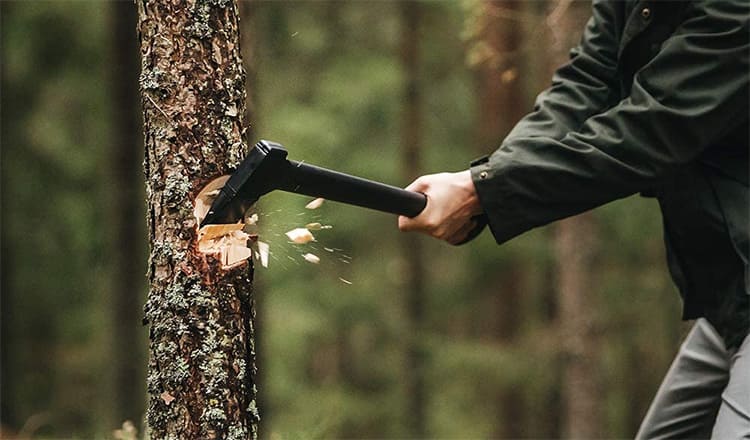
Choosing The Best Axe For Tree Cutting
You need to have a sharp axe, or it’s going to take much longer, and it makes things more dangerous. Like chef’s knives, dull blades are more dangerous than sharp ones, so make sure that when your using an axe, it’s been sharpened.
Also, you want a properly sized axe for the job. A hatchet is not going to be able to cut down a solid old oak tree. It’s made for chopping firewood and small pieces. A bigger axe will have a larger, thicker blade and a longer handle. The best axe size for tree-cutting is around 28-31 inches.
Here are some recommendations:
Fiskars 28-inch Chopping Axe

Features:
- Ideal for felling trees
- Chops deeper with each swing to get more done faster
- Perfected balance and power-to-weight ratio increases swing speed to multiply power
Intertool’s 31-inch Chopping Axe

Features:
- Lightweight design is suitable for outdoor projects at the campsite, garden, and any environment in need of landscaping
- Heavy duty blade is sharp and reinforced with heat treated steel
- Features anti-corrosive coating on the head, keeping the tool safe from rust and wear
The LEXIVON V28 28-inch Chopping Axe
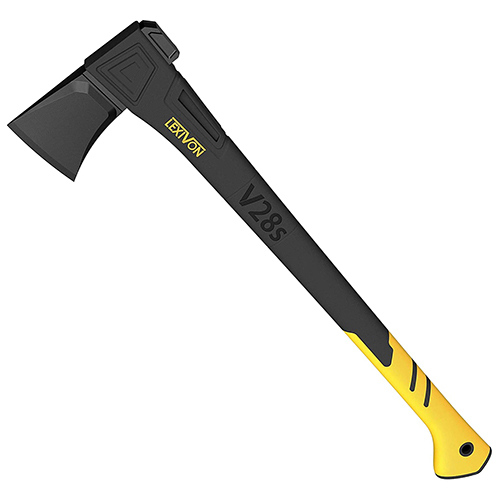
Features:
- Crafted for old-school resilience with new world technology
- Featuring a lightweight, Hi-tech fiberglass haft, Handle-to-Head weight distribution is engineered to produce a perfect swing
- Meticulously designed over-molded Axe head for a long-lasting strike companion
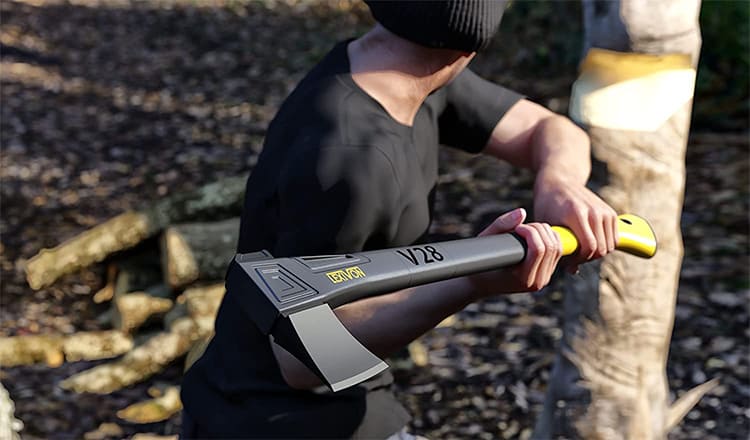
Inspecting The Tree You Want To Cut Down
Before you start cutting, you need to get a game plan together. Try to calculate how wide and tall the tree is, whether it’s leaning, and if there are any limbs that you need to remove before cutting.
If the tree you want to cut is rotting, be aware that the wood is already compromised, so you will want to take extra care because a rotting tree will crumble and fall apart, which may become dangerous if the tree comes down prematurely.
Checking For Vulnerable Animal Life
You’ll also want to make sure that nothing is living in the tree you’re cutting. Porcupines, squirrels, and other animals that can’t simply fly away will make homes in large, dead trees.
And, during the spring, when babies are confined to nests, you may find that you need to relocate something or postpone cutting down a tree until the animals have moved on, especially to help a species at risk. No, it’s not always possible to tell when there is animal life, but the inspection process gives you time to see if there is anything.
If you need help with removing anything from a tree you need to cut, reach out to your local Wildlife Rehab Centre. They’ll know what to do and how to do it in the safest way possible for both the animal and the person relocating it.
Deciding Where The Tree Will Fall
Next, you need to assess where the tree will land when you cut it down. When you’re cutting down a tree, it’s ideal to make it fall in a clearing so that there is minimal damage, and for the most part. However, in a dense forest, that’s not always possible.
You may think that the presence of many trees will help “catch” the tree you cut down, but this is often not the case. When a tree falls into other trees, you’re taking a big risk of the tree falling and bringing down other trees with it or bouncing off of the other trees and falling in the wrong direction.
In this instance, it’s best to try and manipulate the way the tree falls. As mentioned, you can use ropes and wedges to help you make sure that when you’re cutting down a tree, it falls in the right place with minimal to no damage to the rest of the forest.
DeWalt Clear Lens Goggles
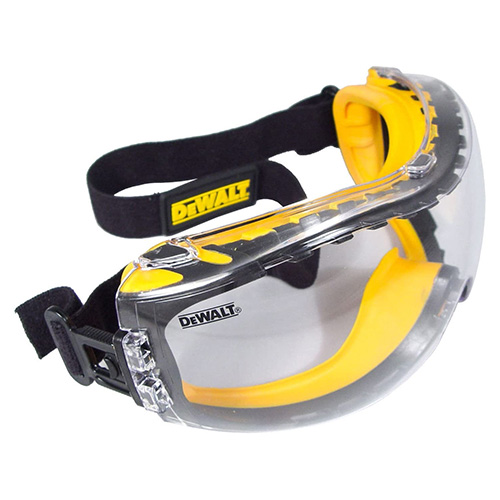
Features:
- Elastic Headband
- Made in the USA or Imported
- DEWALT tough Coat hard coated lens provides tough protection against scratches
Carhartt Work Boots

Features:
- 100% Leather, Imported, Rubber sole
- Shaft measures approximately 5.5" from arch
- Heel measures approximately 1.25"
How To Cut Down A Tree Using An Axe
Now, we’ll get into the actual steps to how you can cut down a tree using an axe. Remember to stay aware of what the tree is doing at all times. And most importantly, make sure that you follow these directions carefully, to keep yourself safe and out of harm’s way.
Step One: Safety Precautions
Felling trees is no joke. You need to take the right steps and safety measures to ensure that no one gets hurt in the process because, let’s face it, trees are big, heavy objects. Mistakes can lead to injury if you’re not careful.
Depending on the size of the tree, it’s very recommended to have a couple of people to help you out as well. Smaller trees may be alright to manage on your own, but if it’s a big tree, enlist a couple of knowledgeable friends to help you.
You don’t want to have too many people though, crowding the area means more potential danger, should the tree fall in the wrong direction. Finally, ensure that you have the right safety equipment like:
Sharp Pebble Sharpening Stone
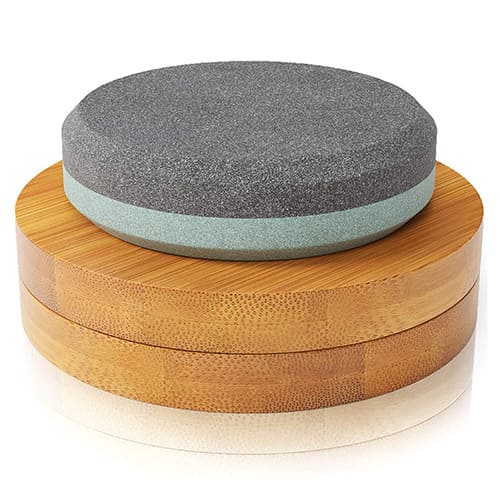
Features:
- Dual grit multipurpose tool sharpener
- No expensive oil needed
- Easy to use
Husqvarna Felling Wedge
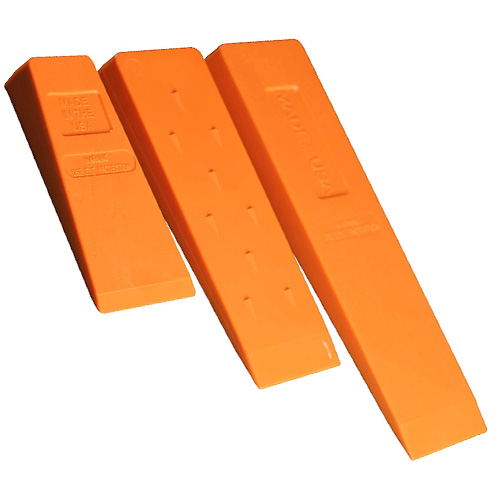
Features:
- Blister Pack5 1/2" Wood Grain/Smooth - High Impact ABS Plastic
- Can also be used for bucking trees already on the ground
- No Master Pack Quantities Required
Arborist Tree Rope

Features:
- 18 KN or approximately 4000 LBS Rated
- Dry Sheath & Core Treated
- Moisture & Water Resistant
Step Two: Make Your Mark
Believe it or not, cutting down a tree by chopping at the lowest possible is more harmful than helpful. The lowest point should be at your knee for smaller trees, and for bigger trees, you should be cutting at the height of your waist.
The point here is to create balance for the tree, to make sure it falls safely and in the right direction. Using an axe, cut two notches into the tree at a downward angle. Your first notch should be as high as your waist, and only a few inches deep, depending on the height and width of the tree.
Next, move around to the other side of the tree and cut a notch a foot above your original notch. This extra notch ensures that the tree will fall both in the right direction and will break in the best place.
Step Three: Bring It Down
The next step is to bring the tree down. For this, you have to move back to your original notch and cut it deeper. This is the dangerous part, so stay vigilant. Remember that when you’re cutting down a tree using an axe, it’s a much slower process than it is with a chainsaw,
Every strike of the axe makes the tree weaker and more likely to snap and fall, which sends sharp wood chips flying in all directions. That’s why it’s so important to wear the right safety gear.
When you hear the tree begin to snap, get out of the way. Pay attention to which way it goes and move in the opposite direction. After the tree has fallen, remove any ties to other trees and begin to chop the tree into smaller pieces for removal.
Conclusion
Cutting down a tree with an axe may prove to be a bit more difficult than with a chainsaw, but it’s one heck of a workout and can actually be safer.
Usually, when using the two-notch method using an axe, you won’t need wedges, but you’re always better off being prepared and having more than you need, than the other way around.
The last thing you want to remember about cutting down a tree is to know when the job is above your pay grade. A massive tree, whether it be wide or tall, or both, should be left to the professionals that have the right knowledge and tools to be able to safely do the job.

